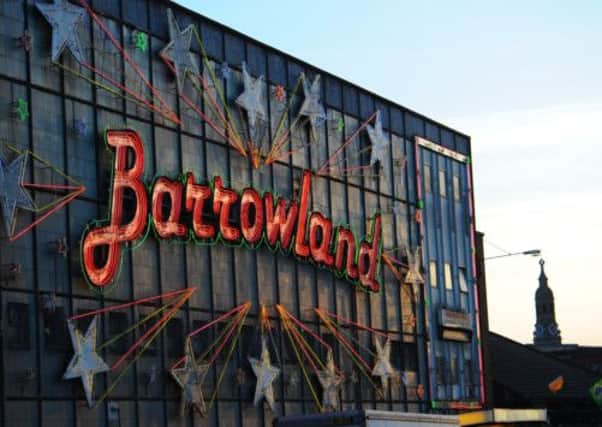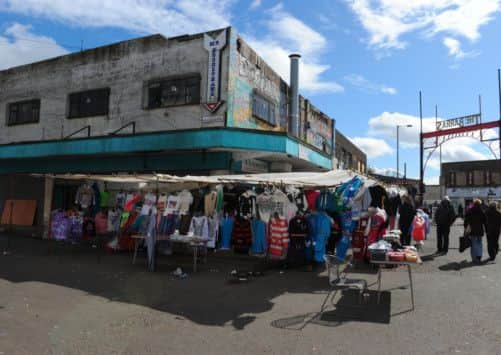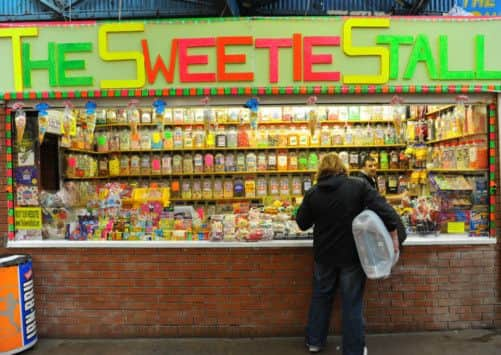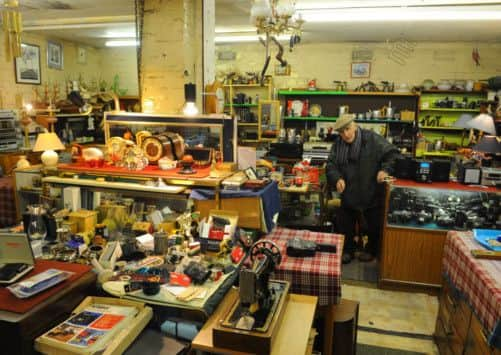Glasgow Barras: Will Games fund save the Barras?


‘YOU,” says Tom Joyes, “are the first civilian to ever see this.” Joyes is manager of the Barrowland Ballroom and has been for 28 of his 61 years. By “civilian” he means someone who is not part of this unique culture, part of the Barras tribe.
It is shortly after 6pm as he leads the way into a narrow room with bare brick walls, at the back of a market stall offering cash for gold. Here, there is a sight any Scottish music fan would likely consider beyond riches. Joyes flicks a switch, unscrews the front of a 2ft-long metal box mounted on one wall, and lifts the lid to reveal tiny brass levers, like piano keys, moving up and down, one after the other. A piece of masking tape, stuck at the base of the box, has letters hand-written on it, one below each lever: B, A, First R, Second R and so on; Little stars, Starburst bottom, Starburst top. This is the mechanism controlling the iconic Barrowland sign, one of the great sights of Glasgow, which since 1960 has shone out into the East End night, a neon beacon of pleasure on those evenings when there is music and dancing to be enjoyed.
Advertisement
Hide AdThe dancehall first opened on Christmas Eve 1934 as an upper floor to the indoor market below, and so next year will celebrate its 80th anniversary. It, like much of the famous market, was owned by Maggie McIver, “the Barras Queen”, who started out in her teens with a fruit and veg stall and by the time of her death, in 1958, was said to be a multi-millionaire – a fortune built, as she put it, with halfpennies and pennies, ingots oot o’ ingins. The ballroom and around 70 per cent of the market is still owned by the same family; Victor Cairns, the managing director, is the grandson of Maggie McIver.


Outside the ballroom on a cold spring night, as the sign flashes above them, almost 2,000 punters are queueing to get inside and see The Fratellis. Right at the front of the queue are Simone Kelly, 17, from Lanark, and Caitlin McLaughlin, 16, from Wishaw. Caitlin has been here since 2pm, Simone since 11am. The idea is to get right to the front of the gig and – hopefully – meet the band. They didn’t know each other beforehand, but are now firm pals, bonding over the hardship of cold pavements, a shared two-litre bottle of Irn-Bru and endless speculation as to which local greasy spoons will allow them inside to pee without having to buy anything.
“The whole fun of it is coming here early and having a laugh,” says Caitlin. “You just come down with a huge bag of munchies and you’re fine.”
“It’s as good as the gig,” says Simone.
Earlier, they had noticed Jon Lawler, The Fratellis frontman, hanging around outside the venue, waiting for a taxi and looking askance at the sex shop across the road. “Is that ...?” they asked each other. “Could that be ...?” But by the time they had looked him up on Wikipedia and verified his identity, he was gone, leaving them heartbroken and still bursting for the loo, but excited by this too-brief glimpse of a star. Such are the thrills and sorrows of the Barrowland queue. Still, at least the goth boy standing behind them had a consoling word. “Youse’re a pair of fannies.”


At 7pm, when the doors open, the crowds pour in like alcopops down a drouthy throat. They climb the stairs. Above them, hanging from the ceiling, is a cart wheel encircled in red neon. This is all that remains of a model – a market trader pushing a barrow – that used to be on the roof. The original building burned down in 1958, and all that survived was this solitary cart wheel, so when the ballroom was rebuilt it was given pride of place above the stairs. Few, in their excitement to get in and see the band, even notice this talisman, but it is arguably the heart of the place.
Going to see a band here is different from seeing a band anywhere else in Glasgow, or indeed in the whole of Scotland. The energy and atmosphere; the smell of lager and burgers and perfume and anticipation. Dust and dry ice drift through blue, orange and pink lights. The ceiling is set with diamonds and stars. The stars are sought-after souvenirs for the musicians who play here. David Bowie is said to have one framed on the wall of a toilet in his Paris home.
Advertisement
Hide AdThe man who climbed up to get a star for Bowie is 53-year-old Billy Coyle, a former stallholder and long-standing employee of Scotia Event Service, better known as the Barrowland Crew – the roadies and other members of stage crew who provide the logistics to make concerts happen. He has worked at countless shows here since 1985.
Anyone fortunate enough to have seen Bob Dylan play in 2004 owes Coyle a debt, as it was thanks to him, in a roundabout way, that the one-off gig came about. Immediately following his SECC show the previous year, Dylan had asked to borrow Coyle’s parka and had put it on, hood up, to walk unnoticed through the crowd as they left the hall, eavesdropping on comments about his performance. Impressed by the enthusiasm of the Glasgow audience, he decided there and then that next time he was in the city he would play its most emblematic venue – the Barrowland – and see those fans close up. Coyle, for his part, has not washed the parka since, and remains an evangelist for the ballroom and its audience. “If you can’t play in here,” he says, “you can’t play anywhere.”
Advertisement
Hide Ad

Stepping between the wooden pillars and on to the dancefloor, into the heat and noise of the Barrowland, is a rite of passage for any Scottish music fan. That noise when the lights go down. A roar, a howl, a pack of hammered, horny wolves. Pints fly through the air, lager sparkling in the spotlights, as the band – tonight, The Fratellis, but it could be anyone – takes the stage in Lowry silhouettes. The famous Hampden roar is, at least these days, the sound of defiance as a prelude to masochism. The Barrowland roar, by contrast, is pure hedonism. It’s about being drunk and young, or remembering being young, and bouncing up and down on the varnished floor, in the tarnished mirrors, in your best jeans, with your best friends, until the room birls and sweat runs hot into your bloodshot eyes. It is about being part of something bigger than yourself, a crowd famous the world over for its fierce joy. It is about leaving the ballroom after the show, out into the cold night, steam rising from your damp clothes and drifting up past the neon sign, and the words of the song playing on the house PA – Sweet Caroline – rasping from every hoarse throat. Good times, they sing, never seemed so good.
DREICH morning weather at Glasgow Cross. The golden cockerels on the clock towers of the Tron, the Tolbooth and St Andrew’s in the Square glare at one another across pubs and pawn shops and agree that it is seven o’clock, high time the Barras opened for the day.
A few minutes further east, and there it is, the famous, sometimes infamous Barras market, sprawled between the Gallowgate and London Road, Bain Street and Ross Street. At this hour, in this weather, there are only a few traders setting up their pitches, and the air rings with the clang of steel frames being hammered together. By nine, though, the market is very much up and running. There are conflicting smells – fried eggs and onions, furniture polish and diesel – and conflicting sounds: Timland, the Celtic shop on the Gallowgate, blasting out This Land is Your Land, while a music stall gives Delilah laldy. And already, on Kent Street, past the red steel archway, the shilpit sellers of fags are chanting their black market mantra, “Cigarettes! Tabacca! Viagra!”
The Barras market dates back to 1921 and is part of what makes Glasgow Glasgow. A peeling yellow sign above one of the halls boasts “Shellfish, Books, Chiropodist”, and that is no idle promise. You can buy whelks from Joe, a guy with one leg, or you can venture further inside for vintage skin mags. The Barras is where you can find it all, from a needle to an anchor, as everyone says; it has a reputation for counterfeit goods, but very little of that is apparent today, and the police cycling through the lanes seem disinclined to make enquiries.
Although the market has been in decline for several years and lacks the buzz it once had, there are still several hundred traders; they all want to earn a pound or two, of course, but the patter comes free. Piero Sanguigni, 31, has a confectionary stall, selling traditional sweets in jars, plus local innovations. Up on the top shelf are Parkhead Humbugs and Ibrox Humbugs, green-and-white and blue-and-white respectively. The sweetie man laughs. “I was thinking about relegating the Rangers ones down to the bottom shelf.”
There are big plans to give the Barras a boost. The council has promised £3.5 million to improve the appearance of the place ahead of the Commonwealth Games, with spending due to begin this summer. Jackie Polson, 51, owns an antiques centre and the Magpie Café in the market, and is a director of the Barrows Enterprise Trust. She believes the money will be a catalyst for further regeneration of the market. “We see the Barras as a national treasure, a heritage site, and feel very strongly that this area should be treated as such,” she says. “It’s about keeping the Barras alive.”
Advertisement
Hide AdSome traders take the view that things have already slid too far and that the market is doomed. What kind of loss would it be if the place closed? “I can’t ever see that happening, but it would be a tragedy,” says Jackie. “It would be just completely wrong if the city allowed a culture like the Barras to disappear.”
It is a culture. A fading culture. The council’s closure in 2009 of nearby Paddy’s Market was regarded by some traders as a form of ethnic cleansing, an attack on the working class – and in particular a class within a class, one with a direct link to the old, rough, colourful Glasgow that has little to do with the bland café society the council often seems to promote. Although the council is now investing in the Barras, there is a general cynicism about motives (tarting it up for tourists) and a feeling that the cash has come too late; that all the paint and new signage in the world will not make a difference. The decline, traders say, has been caused by the fact that there are now so many other places to buy cheap goods that the Barras has lost much of its competitive edge.
Advertisement
Hide AdOthers argue that the economic depression could help the market – a silver lining in everyone else’s cloud. Petrona, a fortune teller from Bellshill who has worked here since the 1980s and has read tarot for Status Quo, predicts a prosperous time ahead for the market. “Oh, God, aye,” she says. “There’s a big future. It’ll be here when I’m no’ here.”
Let us hope Petrona is right. Walking around the Barras, there is a whiff of the brink. Many older traders will tell you they aren’t making money; they come to work because they have always come to work, because their fathers and mothers and grandparents did so before them, and because their friends are here. They are participating in a social ritual and a long tradition. They’ve seen too many “auld yins” die soon after giving up their pitches.
Betty Burrell is a lovely old lady of indeterminate age – don’t ask, she won’t tell – who has been selling handbags in the Barras for a very long time. She grew up in the district. Her mother worked in a mussel shop that had opened in Victoria’s reign. Betty met her late husband, Albert, a Barras trader, in the Barrowland ballroom in 1950. Betty’s mother-in-law sold old clothes at the Barras for half a century. “How she gave up, her eyes went and she couldnae see the money,” Betty explains. “Decimalisation did for her. It used to be she’d tell a ten-bob note by rubbing it on her cheek. She had mair scars than Scarface.”
The day wears on. A watery sun peeps through the clouds. Celtic fans stagger by, celebrating the league win. The cafés are busy selling fish teas, spam fritters, ham ribs and cabbage. Janet and Alan Rae, a middle-aged couple having coffee at a pavement table, let their two huskies, “the Rae twins”, sniff at huge bones bought from the pet food man. A young guy skelps the nose of his pug after it commits a terrible crime at a fabric stall – “Here! Don’t pish oan that cairpet, you!”
Gary Barton, 48, runs Great Eastern Auction Rooms. He calls himself Mister Glasgow. He is a kind of Andy Warhol of the Barras and this junk shop is his Factory; he posts films of the characters who visit on YouTube. He introduces me to Wild Rose Hickok, the widow of a Dennistoun cowboy fan who had changed his name to Wild Bill Hickok. She is just one of a revolving cast who pop in for a cuppa and company. The names of a celebrated few – Wee Johnny Hot Dog, Puppet, Chop Pork Miller – are written on chairs out on the pavement. The Barras, for Gary, is a vital social hub; its true riches are its regulars. “The ordinary person,” he insists, “should have somewhere to come and gab to like-minded people.”
By teatime, the Barras is closing and the rain is on – the rain that has fallen on this place for almost a century. In 2021, that centenary year, will there still be a market on which it can fall? We need the people back, the traders say. The public need to rediscover this place, to fall in love once again with its rough magic.
Advertisement
Hide AdBetty Burrell, for her part, surrounded by handbags and glad memories, is inclined to look on the bright side. “That’s all part of the Barras, intit?” she laughs. “Never say die.”
Twitter: @PeterAlanRoss